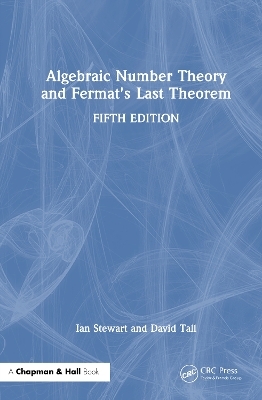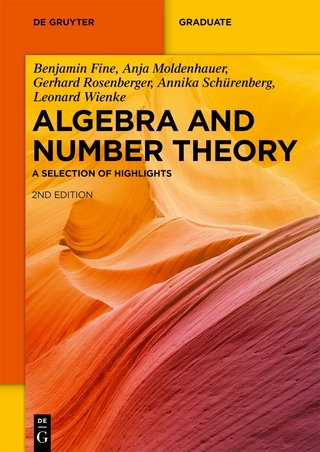
Algebraic Number Theory and Fermat's Last Theorem
Chapman & Hall/CRC (Verlag)
978-1-032-60225-7 (ISBN)
- Lieferbar (Termin unbekannt)
- Versandkostenfrei innerhalb Deutschlands
- Auch auf Rechnung
- Verfügbarkeit in der Filiale vor Ort prüfen
- Artikel merken
Updated to reflect current research and extended to cover more advanced topics as well as the basics, Algebraic Number Theory and Fermat’s Last Theorem, Fifth Edition introduces fundamental ideas of algebraic numbers and explores one of the most intriguing stories in the history of mathematics—the quest for a proof of Fermat’s Last Theorem. The authors use this celebrated theorem to motivate a general study of the theory of algebraic numbers, initially from a relatively concrete point of view. Students will see how Wiles’s proof of Fermat’s Last Theorem opened many new areas for future work.
New to the Fifth Edition
Pell's Equation x^2-dy^2=1: all solutions can be obtained from a single `fundamental' solution, which can be found using continued fractions.
Galois theory of number field extensions, relating the field structure to that of the group of automorphisms.
More material on cyclotomic fields, and some results on cubic fields.
Advanced properties of prime ideals, including the valuation of a fractional ideal relative to a prime ideal, localisation at a prime ideal, and discrete valuation rings.
Ramification theory, which discusses how a prime ideal factorises when the number field is extended to a larger one.
A short proof of the Quadratic Reciprocity Law based on properties of cyclotomic fields. This
Valuations and p-adic numbers. Topology of the p-adic integers.
Written by preeminent mathematicians Ian Stewart and David Tall, this text continues to teach students how to extend properties of natural numbers to more general number structures, including algebraic number fields and their rings of algebraic integers. It also explains how basic notions from the theory of algebraic numbers can be used to solve problems in number theory.
Ian Stewart is an emeritus professor of mathematics at the University of Warwick and a fellow of the Royal Society. Dr. Stewart has been a recipient of many honours, including the Royal Society’s Faraday Medal, the IMA Gold Medal, the AAAS Public Understanding of Science and Technology Award, the LMS/IMA Zeeman Medal, and the University of Warwick Chancellor’s Medal. He has published more than 220 scientific papers and numerous books, including several bestsellers co-authored with Terry Pratchett and Jack Cohen that combine fantasy with nonfiction. David Tall is an emeritus professor of mathematical thinking at the University of Warwick. Dr. Tall has published numerous mathematics textbooks and more than 200 papers on mathematics and mathematics education. His research interests include cognitive theory, algebra, visualization, mathematical thinking, and mathematics education.
I. Algebraic Methods. 1. Algebraic Background. 2. Algebraic Numbers. 3. Quadratic and Cyclotomic Fields. 4. Pell's Equation. 5. Factorisation into Irreducibles. 6. Ideals. II. Geometric Methods. 7. Lattices. 8. Minkowski's Theorem. 9. Geometric Representation of Algebraic Numbers. 10. Dirichlet's Units Theorem. 11. Class-Group and Class-Number. III. Number-Theoretic Applications. 12. Computational Methods. 13. Kummer's Special Case of Fermat's Last Theorem. IV. Elliptic Curves and Elliptic Functions. 14. Elliptic Curves. 15. Elliptic Functions. V. Wiles's Proof of Fermat's Last Theorem. 16. The Path to the Final Breakthrough. 17. Wiles's Strategy and Subsequent Developments. VI. Galois Theory and Other Topics. 18. Extensions and Galois Theory. 19. Cyclotomic and Cubic Fields. 20. Prime Ideals Revisited. 21. Ramification Theory. 22. Quadratic Reciprocity. 23. Valuations and p-adic Numbers.
| Erscheinungsdatum | 03.12.2024 |
|---|---|
| Zusatzinfo | 32 Line drawings, black and white; 32 Illustrations, black and white |
| Sprache | englisch |
| Maße | 156 x 234 mm |
| Themenwelt | Mathematik / Informatik ► Mathematik ► Algebra |
| Mathematik / Informatik ► Mathematik ► Graphentheorie | |
| ISBN-10 | 1-032-60225-2 / 1032602252 |
| ISBN-13 | 978-1-032-60225-7 / 9781032602257 |
| Zustand | Neuware |
| Informationen gemäß Produktsicherheitsverordnung (GPSR) | |
| Haben Sie eine Frage zum Produkt? |
aus dem Bereich


